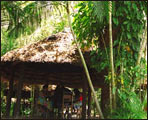The name of Guardalavaca
comes from two  different
sources; one from the pirate activities in the region; supposedly
they kept their hauls on the beach (also named "vacas").
The other version, of more credibility, attributed the name
to the voice that gave the natives when the marine thieves
were getting closer as they were yelling "Guarda la
vaca" (guard the cow; meaning hide the hauls). different
sources; one from the pirate activities in the region; supposedly
they kept their hauls on the beach (also named "vacas").
The other version, of more credibility, attributed the name
to the voice that gave the natives when the marine thieves
were getting closer as they were yelling "Guarda la
vaca" (guard the cow; meaning hide the hauls).
The history of the region dates back to the day when Admiral
Christopher Columbus first saw the Cuban land and said in
a very poetic way: "this is the most beautiful land
that human eyes have ever seen". He pronounced those
words when he disembarked on the Holguin coast in 1492.
It is indeed in the surroundings of Guardalavaca that were
found the most developed settlements of Cuban aboriginals.
It is during the excavation of Chorro de Maita, that the
largest aboriginal cemetery of the Caribbean was discovered.
It is now a museum - located in the same premises as the
excavations.
A few kilometers from Guardalavaca, Gibara was, during
the first part of the Spanish colonization, the most important
port on the northeastern coast; it justifies the development
and splendor that reached the city.
The General of the Independence wars, Calixto Garcia was
born in Holguin. He became one of the great leaders in the
three campaigns for the liberation from the Spanish Regime.
Also, in Biran, a few kilometers from the resort, was born
the President of the State Council and of Ministries, the
Commander-in-chief, Fidel Castro Ruz.
|